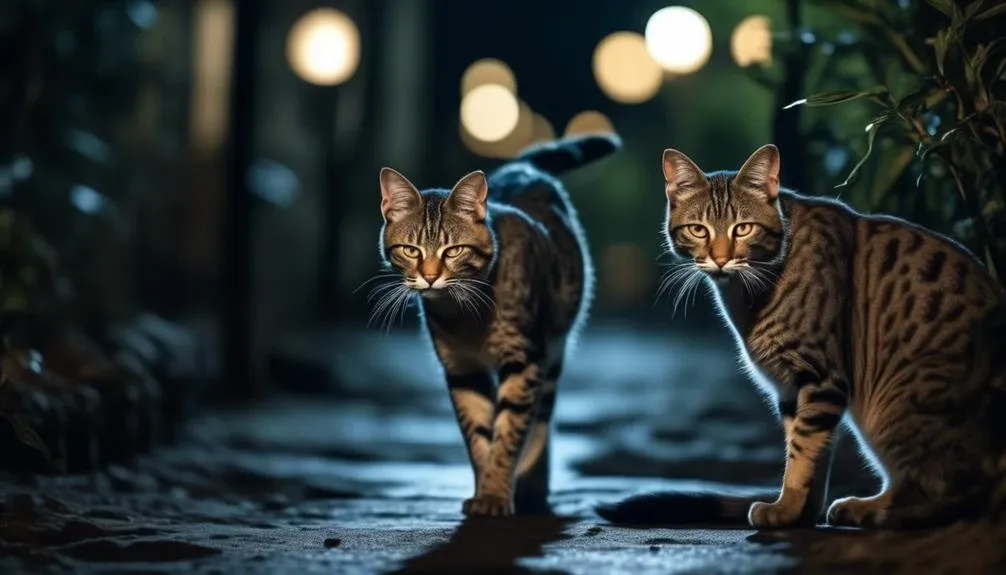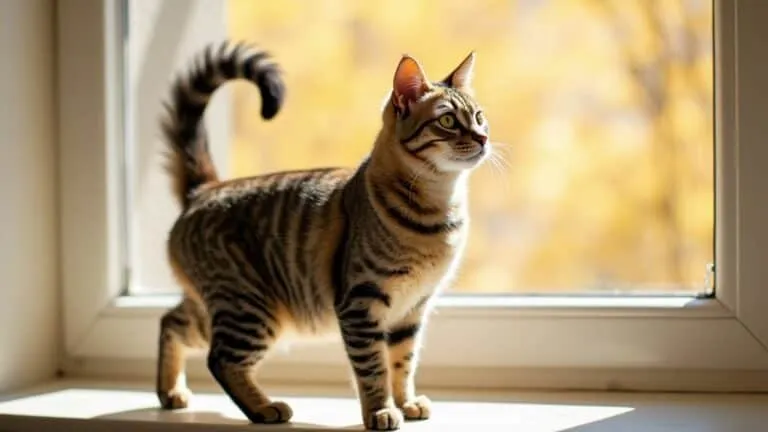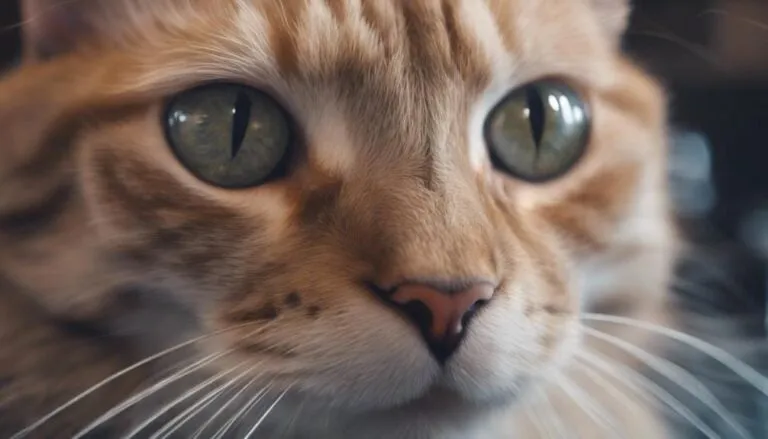The Best Fluffy Pancakes recipe you will fall in love with. Full of tips and tricks to help you make the best pancakes.

Are you aware that feral cats, despite their independence, may exhibit surprising communal behavior when it comes to hunting? Take, for instance, a recent study conducted by researchers in Australia.
They observed a group of feral cats in a remote area and made a remarkable discovery: these seemingly solitary hunters were coordinating their hunting efforts, leading to a higher success rate in catching prey.
This finding raises intriguing questions: Are feral cats truly solitary hunters, or do they possess a hidden inclination towards communal killing?
In this discussion, we will explore the fascinating world of feral cats and their hunting habits, shedding light on whether they are truly solitary in nature or if there is a communal side to their hunting behavior.
Key Takeaways
- Feral cats rely on their instincts and physical abilities to catch prey, using stalking, ambushing, and pouncing techniques.
- Feral cats' hunting habits and prey preferences vary depending on availability and abundance, as well as factors such as age, health, and hunting experience.
- Feral cats can reproduce rapidly and rely on hunting for food, making effective population control measures essential.
- Feral cats not only impact local wildlife through hunting but also pose a threat of disease transmission to domestic pets and wildlife, disrupting the balance of native species in ecosystems.
Hunting Habits of Feral Cats
How do feral cats hunt and what're their preferred hunting methods?
Feral cats are skilled hunters, relying on their instincts and physical abilities to catch their prey. Their prey preferences vary depending on the availability and abundance of certain species in their environment. Feral cats commonly hunt small mammals, such as mice, rats, and rabbits, as well as birds, reptiles, and insects.
Factors influencing their hunting success include the cat's age, health, hunting experience, and the presence of natural obstacles or competition from other predators. Additionally, environmental factors like weather conditions and habitat type can also affect their hunting efficiency.
Feral cats use a combination of stalking, ambushing, and pouncing techniques to capture their prey, taking advantage of their agility and stealth. Their ability to adapt their hunting strategies to different environments contributes to their survival and population growth.
The Difference Between Feral and Stray Cats
Feral cats and stray cats can be distinguished based on their socialization with humans and their comfort level in human presence.
Feral cats are animals that have never been socialized to accept human contact. They exhibit fear and anxiety around people, limiting their interactions.
Stray cats, on the other hand, were socialized to accept human contact and may be former pets. However, if isolated from humans for a long time, stray cats can become feral.
It's important to differentiate between feral and stray cats because feral cats pose a greater challenge for population control efforts. Feral cats, as predators, rely on hunting for food and can reproduce rapidly, leading to an increase in their population.
Effective population control measures, such as trap-neuter-return programs, are essential to manage the feral cat population and prevent them from impacting wildlife and public health.
Feral Cats' Living Conditions
To further understand the living conditions of feral cats, it's important to examine the environments in which they reside and the dynamics within their colonies.
- Colonies:
- Composed of related queens and their kittens
- Queens often nurse and care for kittens from other mothers
- Social structure provides some level of support and protection
- Independent feral cats:
- Some stay in semi-secluded areas close to humans
- Others live in wooded environments and rely on hunting for food
- May face challenges in finding food and shelter
Feral cats' impact on the ecosystem is significant. They're skilled hunters and can negatively affect local wildlife populations. Their role in controlling rodent populations, however, can be beneficial.
Human actions play a crucial role in feral cat populations. Lack of sterilization and abandonment contribute to their existence. Implementing effective trap-neuter-return programs and responsible pet ownership can help manage feral cat populations and minimize their impact on the ecosystem.
Feral Cat Colonies and Their Dynamics
Feral cat colonies exhibit intricate social dynamics within their populations. Social behavior within these colonies is influenced by several factors.
The most significant factor is the availability of resources, such as food and shelter. When resources are abundant, feral cats are more likely to form colonies as they can share the available resources and increase their chances of survival.
Additionally, the presence of related individuals within a colony can also influence its formation. Queens in colonies often nurse and care for kittens from other mothers, indicating a level of cooperation and communal care.
It's important to note that not all feral cats choose to live in colonies. Some prefer to live on their own, finding semi-secluded areas close to humans or relying on hunting in wooded environments for sustenance.
Understanding these dynamics can help in the development of effective management strategies for feral cat populations.
Impact of Feral Cats on Local Wildlife
The presence of feral cats in local ecosystems has raised concerns about their impact on native wildlife. The effect of feral cats on ecosystems is significant and can disrupt the balance of native species. Here are three key points to consider:
- Predation: Feral cats are highly skilled hunters, posing a threat to small mammals, birds, reptiles, and amphibians. Their hunting instincts and population size can lead to declines in local wildlife populations.
- Disease Transmission: Feral cats can carry and transmit diseases to other animals, including domestic pets and wildlife. These diseases can have devastating effects on vulnerable populations.
- Management Strategies: To mitigate the impact of feral cats on local wildlife, various management strategies have been implemented. These include trap-neuter-return programs to control population growth and the establishment of cat-free zones to protect sensitive ecosystems.
Understanding the impact of feral cats on local wildlife is crucial for effective conservation efforts and the preservation of biodiversity. Implementing proper management strategies is essential to minimize the negative effects of feral cat populations on ecosystems.
Frequently Asked Questions
How Do Feral Cats Communicate With Each Other During Hunting?
Feral cats communicate during hunting through vocalizations and scent marking. They use various meows, growls, and purrs to signal their location and intentions. Scent marking helps establish territories and communicate with other cats in the area.
Are There Any Specific Hunting Techniques or Strategies That Feral Cats Use?
Feral cats use stalking and ambush techniques to hunt, pouncing and capturing their prey. They rely on their keen senses and adapt to different environments, making them efficient hunters.
Do Feral Cats Ever Form Hunting Partnerships or Work Together to Catch Prey?
Feral cats, despite their solitary hunting nature, do occasionally exhibit cooperative hunting behaviors. These partnerships, while not common, can have an impact on feral cat populations by increasing their chances of successful prey capture.
How Do Feral Cats Find Food in Urban Environments Where Hunting Opportunities Are Limited?
In urban environments, feral cats may scavenge for food or rely on humans for feeding. Limited hunting opportunities lead to more reliance on scavenging or begging for sustenance. Human intervention can greatly impact their ability to find food.
Are Feral Cats More Successful at Hunting Compared to Domesticated Cats?
Feral cats are generally more successful hunters compared to domesticated cats. They have honed their skills in the wild, relying on hunting for survival. This can have an impact on local ecosystems, as feral cats have the potential to disrupt native wildlife populations.
Conclusion
In conclusion, feral cats exhibit a fascinating mix of solitary hunting and communal behaviors. While they prefer to hunt alone, they may share food primarily with their own offspring.
The estimated population of feral and stray cats in the United States is alarmingly high, ranging from 60 to 100 million. Understanding the difference between feral and stray cats is crucial, as it helps us address their living conditions and the impact they've on local wildlife.
Their complex dynamics and hunting habits continue to intrigue researchers and wildlife enthusiasts alike.








